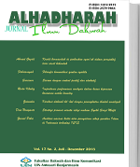Penggunaan Kinesik Dalam Pidato
DOI:
https://doi.org/10.18592/alhadharah.v11i22.1776Keywords:
speech, kinesics, body language/limb movement, facial expressionsAbstract
Kinesics - this is one factor that can be used to increase the attractiveness of speech - as long as its use is right - in accordance with what we express. Expression of limb movement must be the result of due care, preparation, and habits as well as deepening the content of the speech delivered by the desire to be heard, acknowledged and obeyed. Limb movements that do not correspond to what was said can actually make the audience amused and drab. As well as facial expressions or mimic in speech equally important to note. Facial expressions have the impression speech amplifier, but do not be too forced and contrived. If this happens it will make the viewer amused, and possibly be a laughingstock.References
Abidin, Djamalul, Ass. 1996. Komunikasi dan Bahasa Dakwah, Jakarta: Gema Insani Press. Ali, Novel. 1997. Khutbah Dialogis, Jakarta: Khairu Ummah. Birdwhistell, R. 1970. Kinesics and Context. University of Pennsylvania Press, Philadelphia. Blake, Reed H. Haroldsen, Edwin O. 2003. Taksonomi Konsep Komunikasi. Surabaya: Papyrus. Borg, James. 2010. Buku Pintar Memahami Bahasa Tubuh. Yogyakarya: Bungin, Burhan. 2008. Sosiologi Komunikasi-Teori, Paradigma, dan Diskursus Teknologi Komunikasi di Masyarakat. Jakarta: Kencana. Cangara, Hafied. 2003. Pengantar Ilmu Komunikasi. Jakarta: PT Raja Grafindo Persada. Clayton, Peter, 2003, Bahasa Tubuh dalam Pergaulan Sehari-hari. London, Part of Octopus Publishing Group Ltd. Cohen David. 1992. Bahasa Tubuh dalam Pergaulan. London, Sheldon Press, SPCK. Effendy. Davis, Flora.1998.Komunikasi Antarbudaya Panduan Berkomunikasi dengan Orang- Orang Berbeda Budaya. PT Remaja Rosdakarya: Bandung Departemen Pendidikan dan Kebudayaan RI. 1999, Kamus Besar Bahasa Indonesia, Jakarta: Balai Pustaka. Effendy, Onong U. 1989. Kamus Komunikasi. Bandung: Bandar Maju. file.upi.edu/Direktori/FIP/JUR.../IPTM7_BODY_POSTURE.pdf. diakses 27 Maret 2012 pukul 12:30 WITA. Hendrikus, P. Dori Wuwur. 1991. Retorika. Yogyakarta: Penerbit Kanisius. http : // azzkee. multiply. Com / journal / item / 195 / Kinesik _ dalam _ Komunikasi _ Masyarakat
_ Amerika _ dan _ Kaitannya _ dengan _ Kontak _ Kebudayaan. diakses 09 Januari 2012 pukul 00.24 WITA. Knapp, M. 1972. Nonverbal Communication in Human Interaction. Reinhart and Winston Inc., New York. Koehler, Jerry, W., Karl W. E. Anatol and Ronald L. Applbaum. 1987. Public Commuication, London: MacMillan Publishing. Komunikasi Masyarakat Kontemporer. PT.Remaja Rosdakarya: Bandung Kumar, Vijaya. 2002. Body Language. Motilal Banarsidass: Delhi Kushartanti.2005. Pengantar Linguistik Umum. Gramedia Pustaka Utama: Jakarta Leathers, D.G. 1976. Nonverbal Communication System. Sydney : Allyn and Bacon, Inc. Liliweri Alo. 1994. Komunikasi Verbal dan Nonverbal. Bandung: PT. Citra Aditya Bakti. Liliweri, Alo. 2009. Dasar-Dasar Komunikasi Antarbudaya. Yogyakarta: Pustaka Pelajar. Lim Nan Sen, Irwin. 1987. Bahasa Tubuh/Body Talk. Batam: Inter Aksara. Littlejohn, Stephen W. & Karen A. Foss. 2009. Teori Komunikasi: Theories of Human Communication. Edisi Kesembilan. Terjemahan oleh Mohammad Yusuf Hamdan. Jakarta: Salemba Humanika. Lubis, Basrah. Tth. Metodologi dan Retorika Dakwah, petunjuk praktis khutbah dan pidato, Jakarta: CV. Tursina. McDermott, R. 1980. Profile: Ray L. Birdwhistell, The Kinesis Report 2, 3: 1-16. Mulyana Deddy. 2001. Ilmu Komunikasi Suatu Pengantar. Bandung: PT. Remaja Rosdakarya. Muthmainnah, N., dan Fauzi, M. 1996. Psikologi Komunikasi. Universitas Terbuka. Muyana, Deddy. 1999. Nuansanuansa Komunikasi Meneropong Politik dan Budaya Pease, Allan. 1981.Body Language.Sheldon Press: London Rakhmat, Jalaluddin. 2005. Psikologi Komunikasi. PT.Remaja Rosdakarya: Bandung Timur, Lintang. 2010. Rahasia Membaca Pikiran Orang Lewat Bahasa Tubuh Semudah Membaca Tulisan. Yogyakarta: Parasmu. Wiyanto, Asul. 1990. Pidato dan Diskusi, Surabaya: PT. Bina Ilmu.
Downloads
Published
How to Cite
Issue
Section
License
Authors retain copyright and grant the journal the right of first publication, with the work simultaneously licensed under the Creative Commons Attribution-NonCommercial 4.0 International Public License (CC BY-NC 4.0). This license allows reusers to distribute, remix, adapt, and build upon the material in any medium or format for noncommercial purposes only, provided that proper attribution is given to the original creator.







